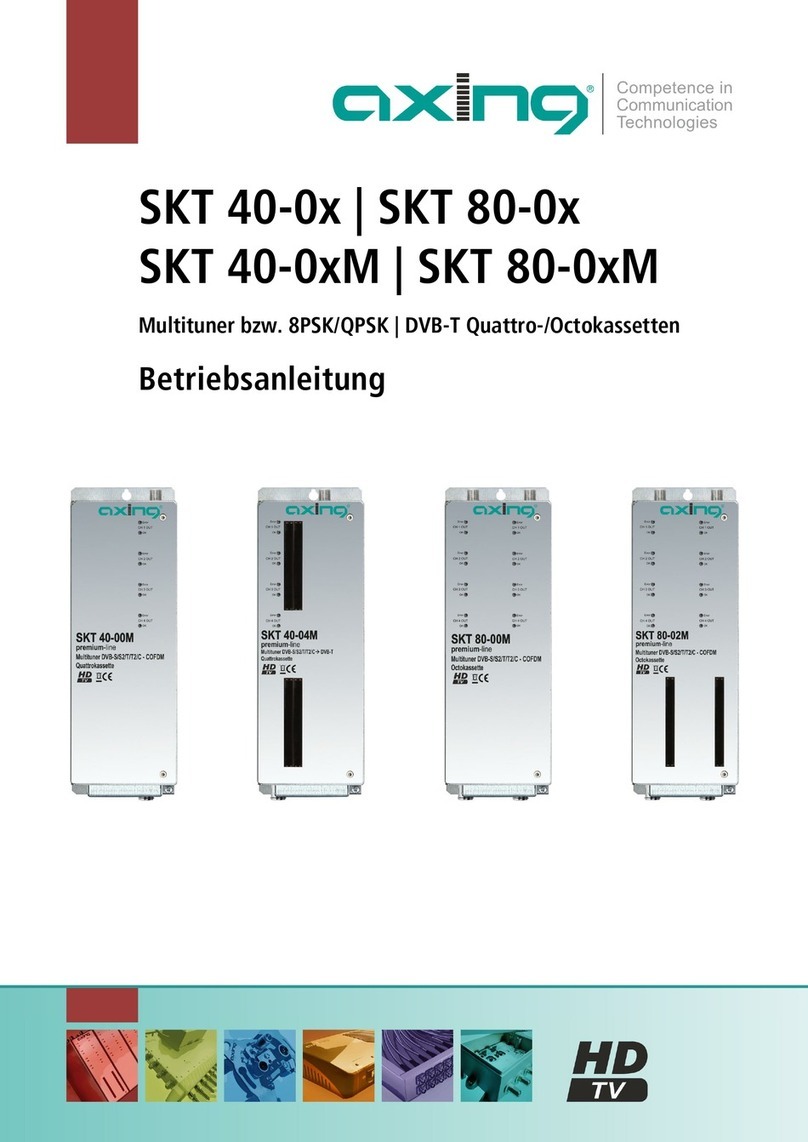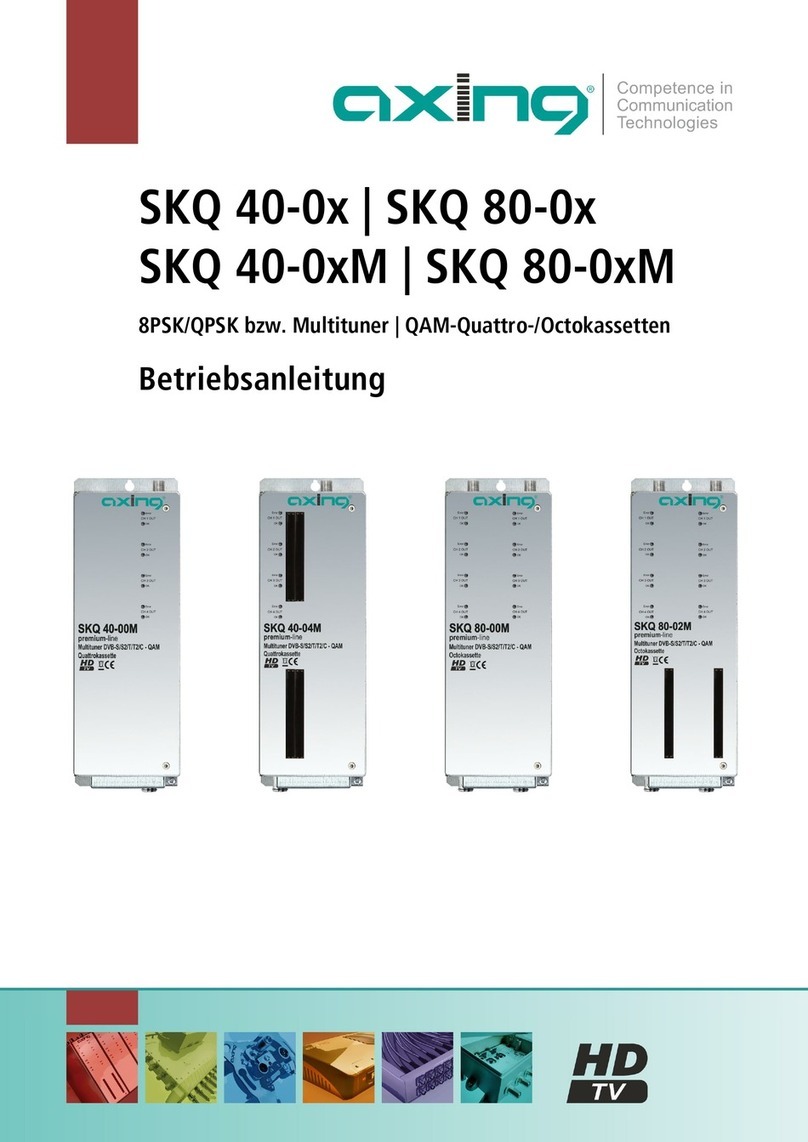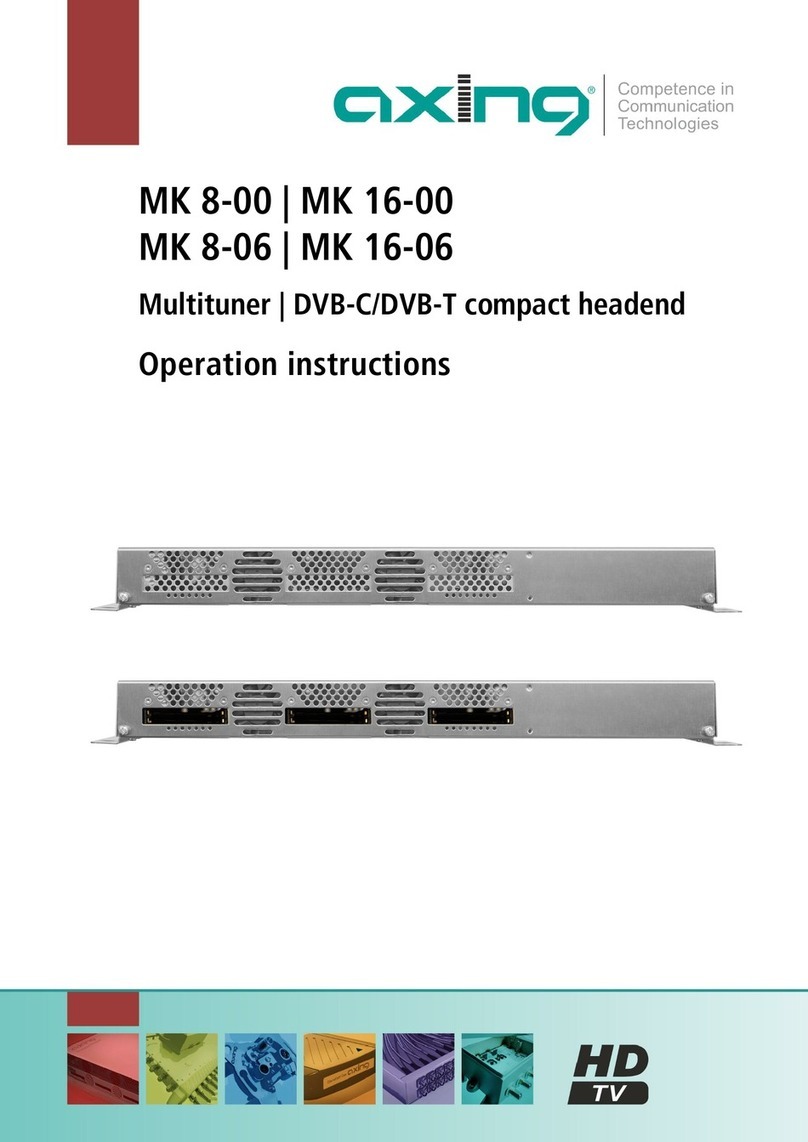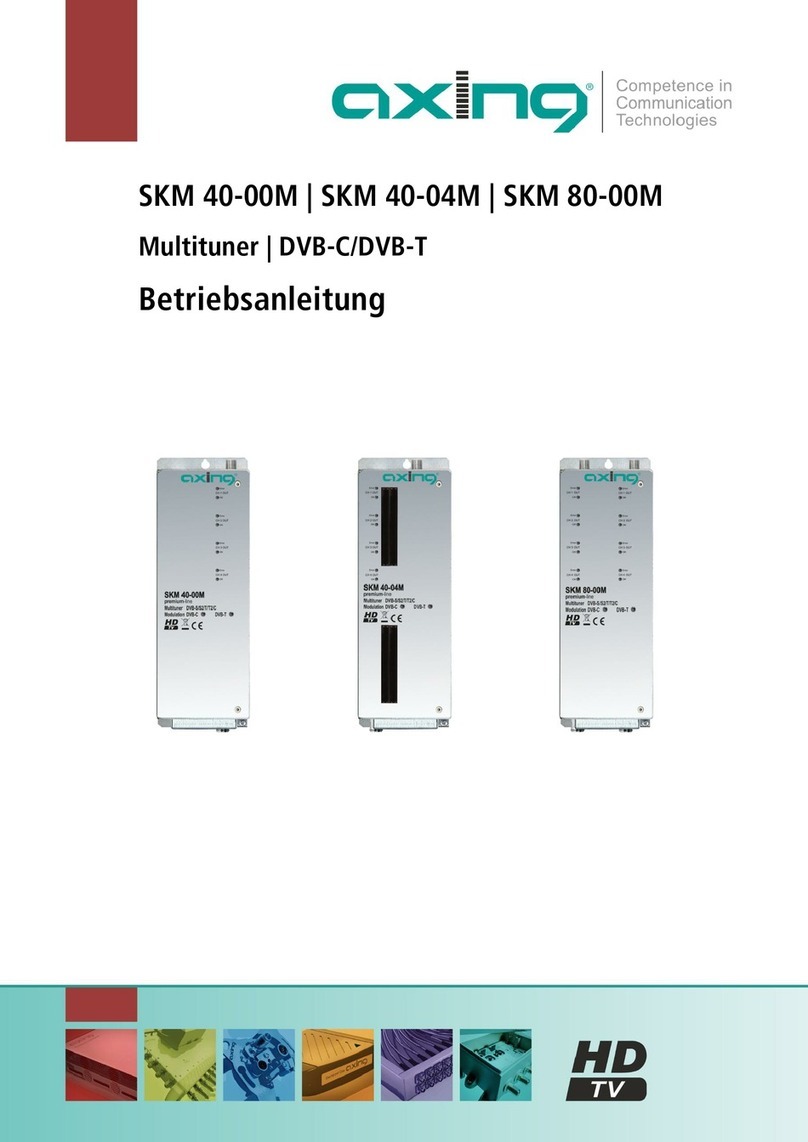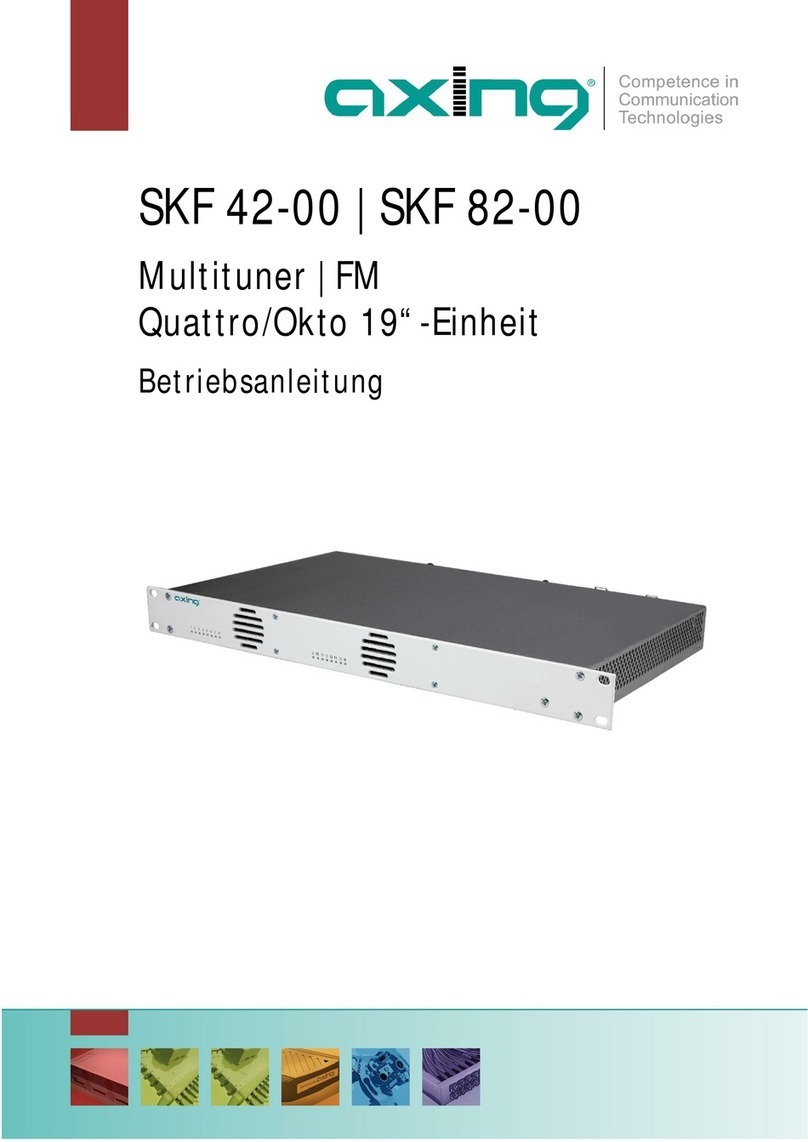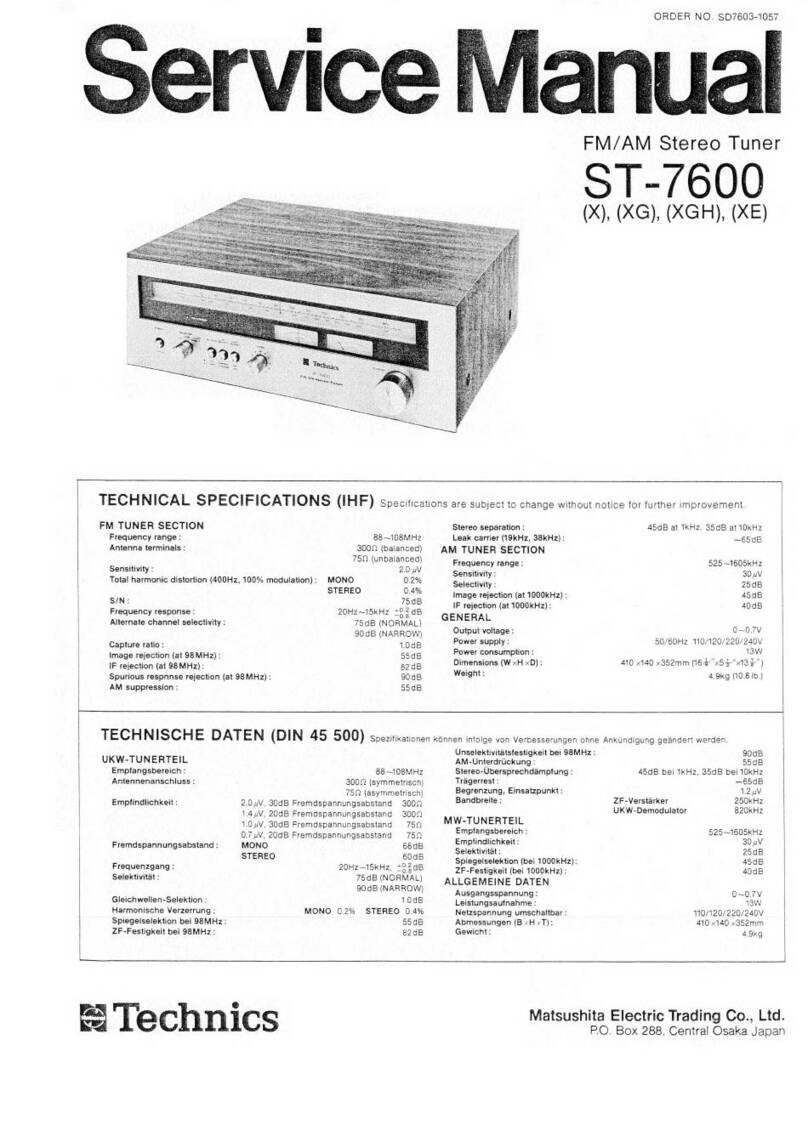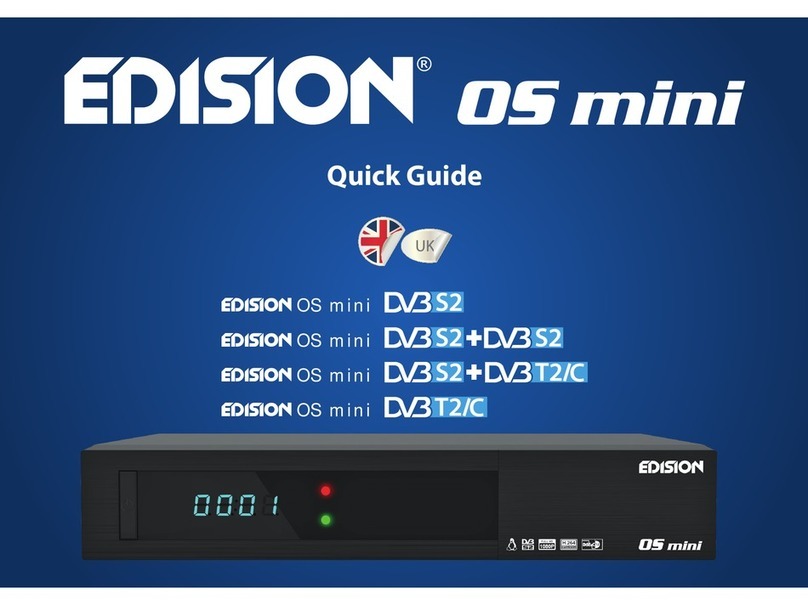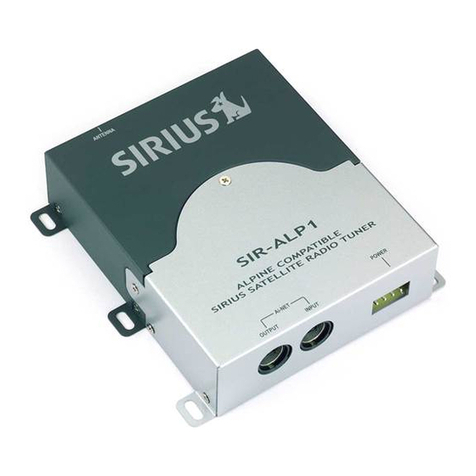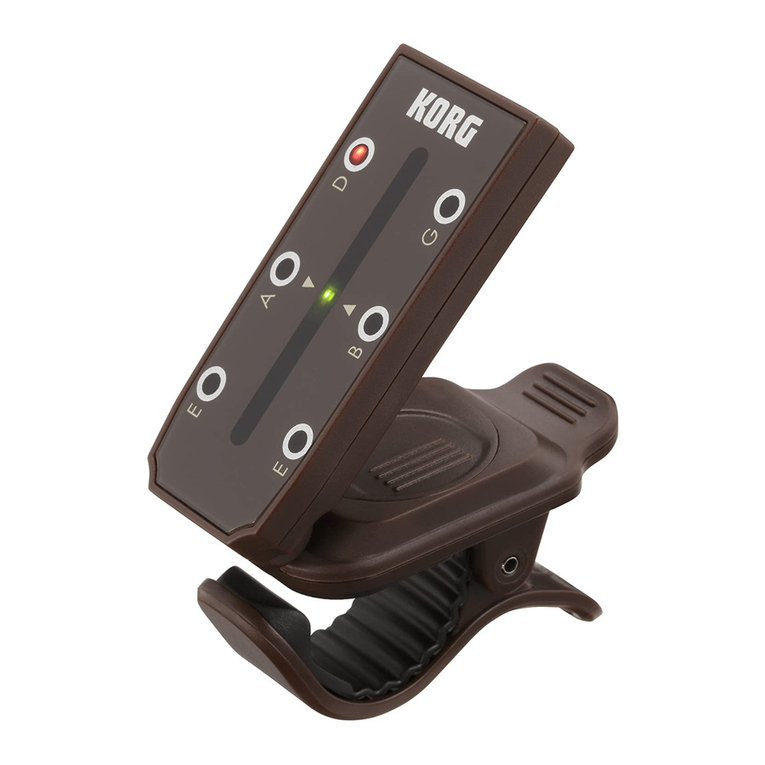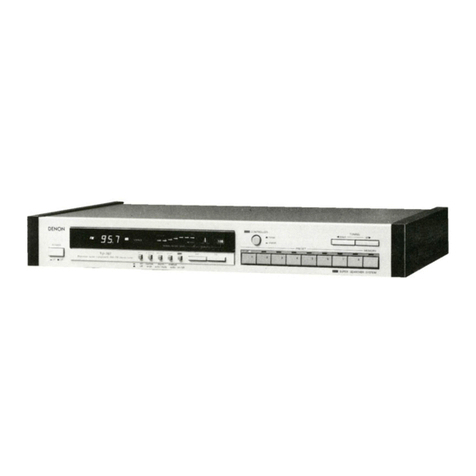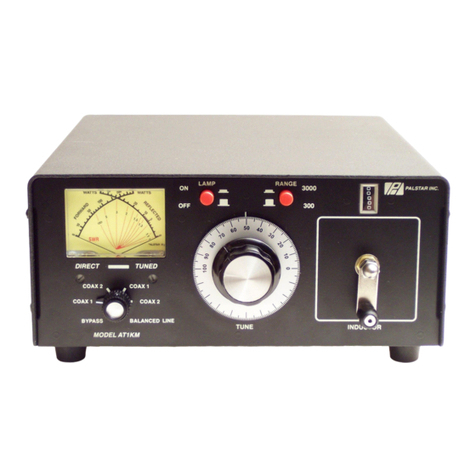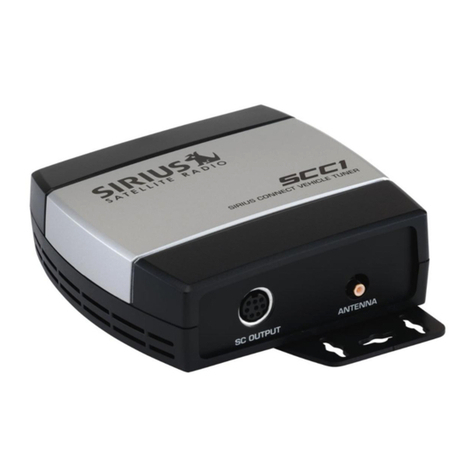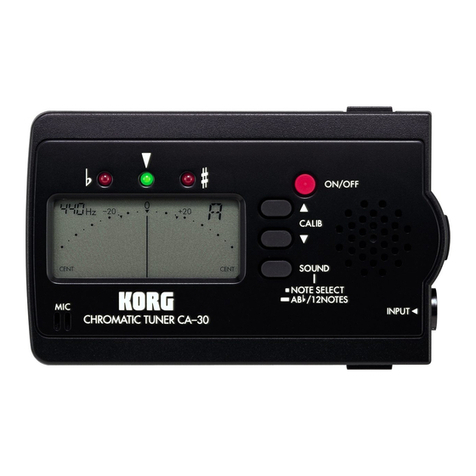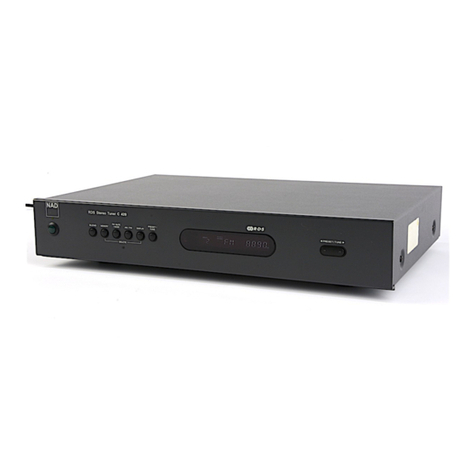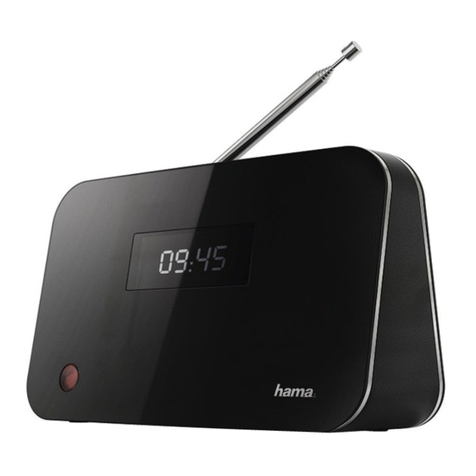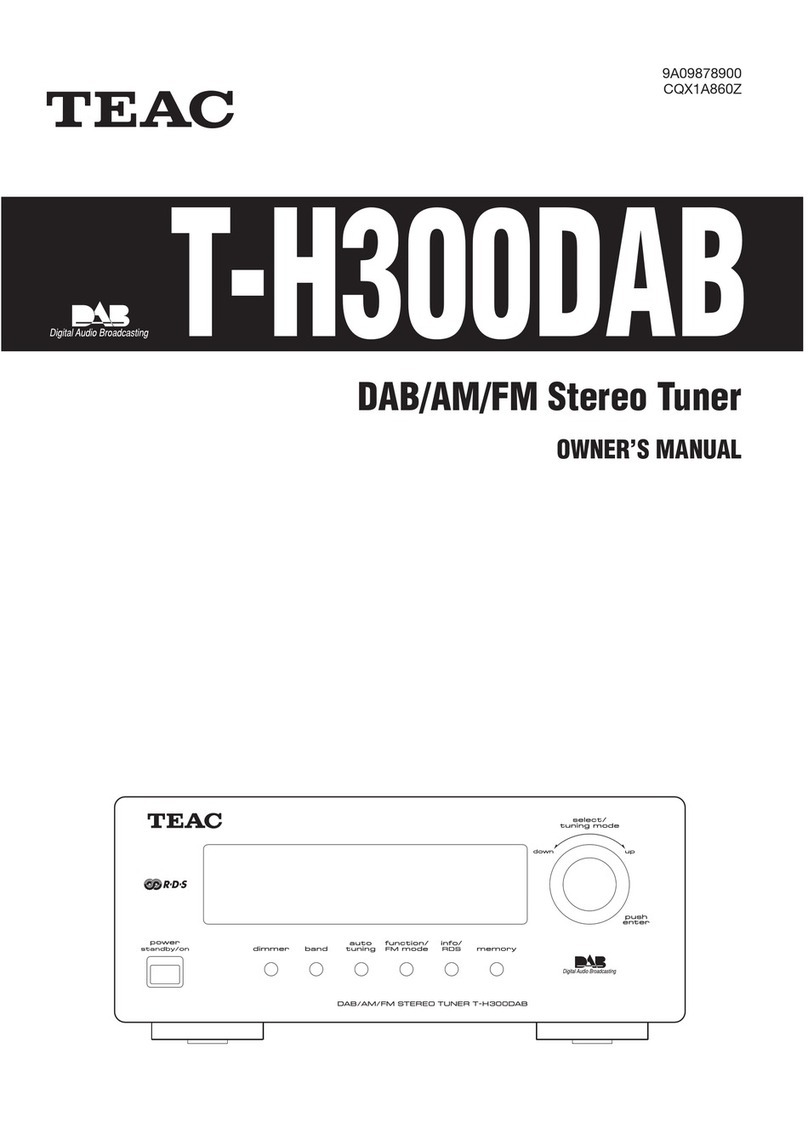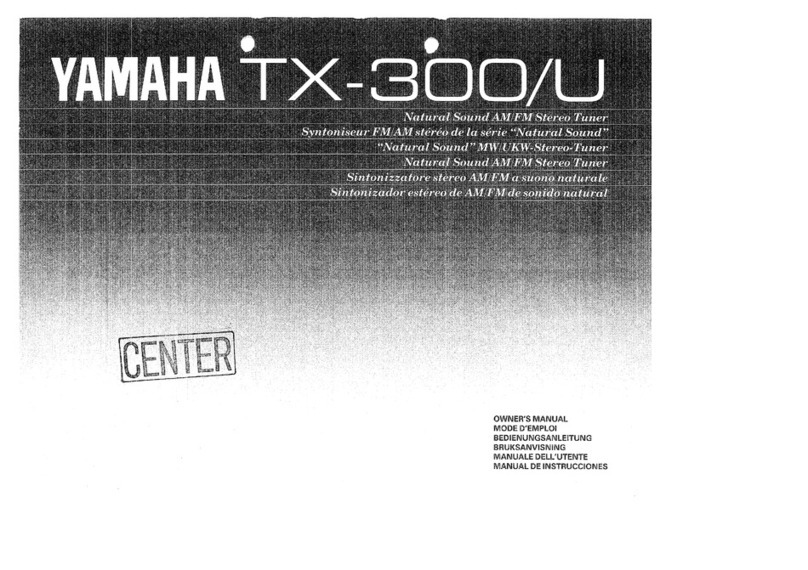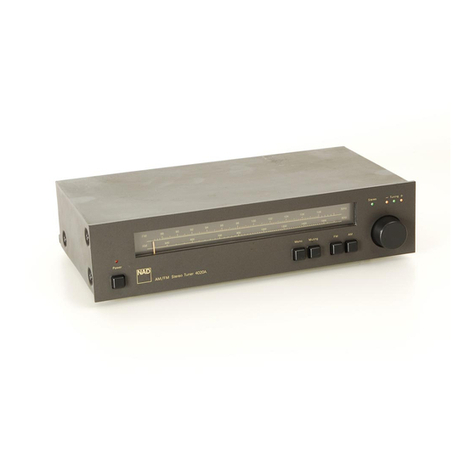axing MK 8-00 User manual

MK 800 | MK 1600
MK 806 | MK 1606
Multituner | DVB-C/DVB-T compact headend
Operation instructions

Ta le of contents
1. Product description...............................................................................................................................................4
1.1. General......................................................................................................................................................... 4
1.2. Scope of delivery.........................................................................................................................................4
1.3. Inputs/multituner..........................................................................................................................................5
1.4. Output/modulators.......................................................................................................................................6
1.5. Grap ical user interface...............................................................................................................................6
1.6. SMARTPortal..............................................................................................................................................6
1.7. Display elements and connectors.................................................................................................................7
1.7.1. MK 800/160x......................................................................................................................................7
1.7.2. MK 806/1606......................................................................................................................................7
2. Mounting and Installation.....................................................................................................................................8
2.1. Wall mounting..............................................................................................................................................8
2.2. Mounting in a 19“ rack.................................................................................................................................8
2.3. Equipotential bonding..................................................................................................................................9
2.4. Power supply................................................................................................................................................9
2.5. RF Installation............................................................................................................................................10
2.5.1. Connection to DVB-T/T2 or DVB-C.................................................................................................10
2.5.2. Connection to DVB-S/S2/S2x...........................................................................................................10
2.5.3. Output................................................................................................................................................10
2.5.4. Connection to t e Internet..................................................................................................................11
3. Configuration......................................................................................................................................................12
3.1. Login and logout........................................................................................................................................12
3.2. Front page.................................................................................................................................................. 14
3.2.1. Input..................................................................................................................................................14
3.2.2. Outputs.............................................................................................................................................. 14
3.3. Initialization p ase 1..................................................................................................................................15
3.3.1. DVB-S/S2/S2x..................................................................................................................................15
3.3.2. DVB-C, DVB-T or DVB-T2.............................................................................................................16
3.3.3. Bit error rate......................................................................................................................................17
3.3.4. Found programmes............................................................................................................................17
3.4. Initialization p ase 2..................................................................................................................................17
3.4.1. Remux mode.....................................................................................................................................18
3.4.2. Cross Multiplex Mode.......................................................................................................................19
3.4.3. LCN (Logical C annel Numbering)..................................................................................................21
3.5. Initialization p ase 3 – DVB-C..................................................................................................................22
3.5.1. Configuration of t e modulator.........................................................................................................22
3.5.2. Fill level............................................................................................................................................23
3.5.3. Selected Programmes........................................................................................................................23
3.6. Initialization p ase 3 – DVB-T..................................................................................................................24
3.6.1. Configuration of t e modulator.........................................................................................................24
3.6.2. Fill level............................................................................................................................................26
3.6.3. Selected Programmes........................................................................................................................27
3.7. Maintenance............................................................................................................................................... 28
3.7.1. Updating firmware/software..............................................................................................................28
3.7.2. Modulation standard..........................................................................................................................29
3.7.3. C anging t e IP address....................................................................................................................29
3.7.4. C anging t e password......................................................................................................................31
3.7.5. Rebooting..........................................................................................................................................31
3.7.6. Erasing service data...........................................................................................................................31
3.7.7. Save Initialization Data.....................................................................................................................32
3.7.8. Upload Initialization Data..................................................................................................................32
3.7.9. Device name......................................................................................................................................33
3.7.10. Access to SMARTPortal....................................................................................................................33
3.7.11. Log files............................................................................................................................................ 34
2 2018-01-31 | Tec nical improvements, c anges in design, printing- and ot er errors expected.

3.7.12. C annel list for all devices................................................................................................................34
4. Use of CA modules.............................................................................................................................................35
4.1. Insertion of CA modules.............................................................................................................................35
4.2. CI menu for MK 806/1606.........................................................................................................................35
4.2.1. Using CI menu..................................................................................................................................35
4.3. Decryption of programmes.........................................................................................................................36
5. Tec nical specifications......................................................................................................................................37
Safety instructions:
T e installation of t e device and repair work on t e device must be carried out only by a professional
in accordance wit t e applicable VDE directives. In case of incorrect installation, no liability is
assumed.
Never open t e device. T ere are no parts to be maintained by t e user inside t e device, owever,
let al voltages are present. T is also applies to cleaning t e device or working on t e connections.
Use only t e mains cable enclosed to t e device. Never replace any parts or make any modifications to
t e mains cable. Ot erwise, t ere is a risk of deat .
If you intend not to use t e device for a longer period of time, we recommend you to completely
disconnect t e device from t e mains for safety reasons and for saving energy by pulling out t e mains
plug.
Let t e device adjust to t e room temperature before commissioning, in particular if condensation is
present on t e device, or if it was exposed to large temperature fluctuations.
T e device must be operated only in moderate climate.
T e device must be operated only in dry rooms. In damp rooms or outdoors, t ere is a risk of s ort-
circuits (attention: risk of fire) or electrical s ocks (attention: risk of deat ).
T e device s all not be exposed to dripping or splas ing. Do not place objects filled wit liquids suc
as vases on t e device.
Plan t e mounting or installation location suc t at you can easily reac t e mains plug and interrupt
t e electric circuit in dangerous situations. Select t e mounting or installation location suc t at
c ildren cannot play near t e device and its connections wit out supervision. T e mounting or
installation location must allow a safe installation of all connected cables. Power supply cables and
supply cables must not be damaged or squeezed by any objects.
Operate t e device only on a flat, firm surface and protect it against unintentional movements.
Never expose t e device to direct solar irradiation and avoid direct vicinity of eat sources (e.g. eaters,
ot er electrical appliances, fireplace, etc.). It must be always ensured t at devices wit cooling elements
or ventilation slots are not covered or obstructed.
Ensure generous air circulation around t e device. T is will prevent possible damage to device and risk
of fire due to over eating. It must be always ensured t at cables are not located near eat sources (e.g.
eaters, ot er electrical appliances, fireplace, etc.). T e unit must be wall mounted wit at least 5 cm
clearance along t e 4 sides. For 19-inc rack mounting, t ere must be at least 5 cm clearance in front of
and be ind t e unit.
In particular, t e warranty and liability s all be excluded for t e consequences of incorrect use, in case
of incorrect modifications or repair work carried out by t e customer. Use t e device only as described
in t e operating instructions and in particular according to t e state-of-t e-art.
T e antenna system must be installed and grounded according to t e current DIN EN 60728-11
standard.
Herewit AXING AG declares t at t e marked products comply wit t e valid
guidelines. You can call up t e complete EU declaration of conformity for
download by entering t e article in t e searc field at www.axing.com.
WEEE Nr. DE26869279 | Electrical and electronic components must not be
disposed of as residual waste, it must be disposed of separately.
2018-01-31 | Tec nical improvements, c anges in design, printing- and ot er errors expected. 3

1. Product description
1.1. General
MK 800 Eig t independent multituner inputs
Transmodulates 8 × DVB-S/S2/S2x/T/T2/C into 8 × DVB-C or DVB-T (depending on t e
configured modulation standard, see 3.7.2 on page 28)
MK 1600 16 independent multituner inputs
Transmodulates 16 × DVB-S/S2/S2x/T/T2/C into 16 × DVB-C or DVB- T (depending on t e
configured modulation standard, see 3.7.2 on page 28)
Common Features:
Remux | Crossmultiplex
Web-based configuration | Remote maintenance
Suitable for AXING SMARTPortal
Can be used for wall mounting or as a 19" unit
Built-in power supply
1.2. Scope of delivery
1 × Compact eadend
1 × AC power cord
1 × Quick start guide
4 2018-01-31 | Tec nical improvements, c anges in design, printing- and ot er errors expected.

1.3. Inputs/multituner
Headend devices wit multituner can receive DVB-S/S2/S2x, DVB-T/T2 or DVB-C. For receiving DVB-T/T2
or DVB-C the LNB power has to e switched off efore connecting a antenna ca el to one of the HF inputs
(see 3.3.2 on page 16)!
Direct connection to the LNBs
T e devices ave a remote supply voltage for t e LNB and DiSEqC 1.0 functionalities at t e inputs. T e inputs
can be connected directly to t e LNB.
Multiswitches as input distri utors (recommended)
Optionally, you can also use multiswitc es as input distributors. T e advantage of t is solution is t at you can set
bot t e polarization and t e satellite via t e user interface. C anges in t e list of programmes can be made using
remote maintenance, so t at it is not necessary to c ange or modify t e input distribution on site.
Demodulation of the data stream
T e selection of t e frequency and t e demodulation of t e data stream are bot done in t e tuner.
If needed, t e programmes from t e data flow of t e demodulated transponder can be filtered (Remux mode).
T anks to t e Cross Multiplex Mode, FTA programmes (Free to Air) can be filtered from t e data flow of several
tuners for a common output c annel and be bundled again.
T e prepared data flow is passed on to t e modulators.
2018-01-31 | Tec nical improvements, c anges in design, printing- and ot er errors expected. 5

1.4. Output/modulators
T e MK 80x ave eig t output modulators. T e MK 160x ave 16 output modulators. All modulators can be set
to any output c annel (DVB-C = S2…K87 | DVB-T = S2…K69).
1.5. Graphical user interface
T e settings can be c anged via t e user interface of t e integrated web interface. To access t e user interface
and t us configure t e devices, you need a standard PC/laptop wit a network interface and t e actual version of
t e installed web browser (left).
T e configuration interface is "mobile ready" and can t erefore also be used from t e smartp one or tablet
(rig t).
1.6. SMARTPortal
6 2018-01-31 | Tec nical improvements, c anges in design, printing- and ot er errors expected.

1.7. Display elements and connectors
1.7.1. MK 8/160x
1. LED indicators
Green = modulation is ok
Green (blinking) = somet ing is missing from t e programmed TS
Red = modulator overload.
2. Equipotential bonding connection
3. Mains connection
4. HF input LEDs:
Yellow = MPEG data stream present,
Off = MPEG data stream not present
5. RF input 1…4
6. RF input 5…8
7. RF input 9…12 (MK 16-0x only)
8. RF input 13…16 (MK 16-0x only)
9. Test port
10. RF output
11. RJ45 Et ernet connector
1.7.2. MK 806/1606
MK 806 and MK 1606 eac ave 6 common interfaces (CI1 ... CI6).
W ic encrypted program you decrypt wit w ic interface, you determine in t e configuration.
2018-01-31 | Tec nical improvements, c anges in design, printing- and ot er errors expected. 7

2. Mounting and Installation
Installation must be performed by aut orized and skilled electricians only.
Before mounting and installation, pull t e mains plug (1)!
T e antenna system must be installed and grounded according to t e EN 60728-11 standard.
T e compact eadend can be mounted on eit er at t e wall or be mounted in a 19 "rack.
2.1. Wall mounting
T e compact eadend are factory-fitted wit wall brackets.
Note: T e unit must be wall mounted wit at least 5 cm clearance along t e 4 sides.
T e installation must be carried out on an even and vertical surface (any unevenness must be compensated).
Fix t e eadend wit wit minimum four pcs of 4 × 30 mm screws.
T e eadend must be connected to t e equipotential bonding according to EN 60728-11 (3)
2.2. Mounting in a 19“ rack
Note: For 19-inc rack mounting, t ere must be at least 5 cm clearance in front of and be ind t e unit.
Remove t e wall bracket from t e ousing of t e compact eadend.
Mount t e front plate MKZ 1-00 onto t e MK 800 / 1600 (1).
8 2018-01-31 | Tec nical improvements, c anges in design, printing- and ot er errors expected.

Slide t e compact eadend into t e 19 "rack.
Screw t e compact eadend wit four screws (2).
Maintain t e EN 60728-11.
2.3. Equipotential onding
To connect t e outer conductor of t e coaxial cable to t e equipotential bonding, use e.g. QEW eart ing
angles or CFA eart connection blocks at t e inputs and output (see 2.5 on page 10).
2.4. Power supply
T e 19 "units ave a built-in power supply. For example, connect t e units to an electrical outlet (100 ... 240
VAC / 50 ... 60 Hz).
2018-01-31 | Tec nical improvements, c anges in design, printing- and ot er errors expected. 9

2.5. RF Installation
2.5.1. Connection to DVB-T/T2 or DVB-C
Before connecting the antenna ca el, the LNB power has to e switched off (see 3.3.2 on page 16). Active
DVB-T antennas have to e supplied y an external power supply.
2.5.2. Connection to DVB-S/S2/S2x
Connection to the LNBs
On t e SAT-IF input t e compact eadends ave a remote supply voltage for t e LNB and use DiSEqC 1.0
functionalities. T erefore, t ey can be connected directly to t e LNB.
Multiswitches as input distri utors
Optionally, you can also use multiswitc es as input distributors. T e advantage of t is solution is t at you can set
bot t e SAT IF level and t e satellite via t e user interface. C anges in t e list of programmmes can be made
using remote maintenance, so t at it is not necessary to c ange or modify t e input distribution on site.
2.5.3. Output
If you use more t en one compact eadend, you ave to use a combiner to combine t e output signals.
Note: T ere as to be used galvanic isolator between t e output connector and antenna network in Sweden and
Norway state area.
10 2018-01-31 | Tec nical improvements, c anges in design, printing- and ot er errors expected.

2.5.4. Connection to the Internet
Connection via Et ernet over Coax to a router w ic is connected to t e Internet.
Connection via EoC 2-01 in „Bridge Client Mode“ to a WLAN router.
2018-01-31 | Tec nical improvements, c anges in design, printing- and ot er errors expected. 11

3. Configuration
T e device is configured via t e grap ical user interface of t e integrated web interface.
To access t e user interface, you need a standard PC/laptop wit a network interface and t e actual version of t e
installed web browser. To connect t e network interface of t e eadend to t e computer, you need a
commercially available network cable.
T e HTTP protocol is used for communication allowing a worldwide remote maintenance of t e systems at
various locations via t e Internet. Access protection is implemented by means of t e password prompt.
IP address: 192.168.0.145
Subnet mask: 255.255.255.0.
T e computer and t e eadend must be in t e same subnetwork. T e network part of t e IP address of t e
computer must be set to 192.168.0. and t e subnet mask must be set to 255.255.255.0.
T e ost part of t e network address is required for t e identification of t e devices and can be assigned in t e
subnetwork only once. You can allocate to t e computer any not allocated ost address between 0 and 255.
Hint:
C ange t e IP address and t e subnet mask of your computer accordingly.
(e.g.: IP address:192.168.0.11 and subnet mask: 255.255.255.0)
Control panel > Network connections > LAN connection >Properties > Internet protocol version 4 TCP/IPv4 >
Properties > Use the following IP address:
Click OK to save.
Start your web browser and enter t e IP address of t e eadend: e.g.: 192.168.0.145.
3.1. Login and logout
T e web-based user interface is protected against unaut orized access. W en accessing t e user interface, t e
first t ing is t e password request.
12 2018-01-31 | Tec nical improvements, c anges in design, printing- and ot er errors expected.

Enter t e default password: amsen8262
Click ENTER PASSWORD.
If you are not automatically forwarded to t e start
page, click OPEN PAGE.
T e standard language of t e user interface is Englis . In t e eader, t e t e language of t e user interface can be
c anged. T e possibilities are German (DE) and Englis (EN). T e c osen language applies until t e end of t e
session.
To log out, click LOG OUT.
Notes:
If t e browser is closed w ile you are still logged in, an automatic logout occurs 2.5 minutes later.
If t e browser window stays open, t ere is no automatic logout. It allows monitoring t e installation via t e
web browser.
Changing the password:
Please c ange t e password immediately after t e first commissioning and c oose a sufficiently safe
password. Keep t is password at a safe place.
Menu item: MAINTENANCE > SET NEW PASSWORD (see 3.7.4 on page 30).
Changing the IP address:
If needed, t e eadends can be integrated in a network. For t is application, some c anges must be applied to t e
network configuration.
Menu item MAINTENANCE > SYSTEM.
2018-01-31 | Tec nical improvements, c anges in design, printing- and ot er errors expected. 13
Language

3.2. Front page
T e relevant information required for t e function of t e system are s own on t e front page. T e decisive t ing
is t e quality of t e signals at t e INPUT and t e utilization of t e modulators at t e OUTPUT.
3.2.1. Input
T e bit error rate BER of all four tuners is s own on t e left side. T e amount of bit errors for t e last 1,000,000
transferred bits is calculated.
Also t e LEVEL and t e C/N ratio are s own.
3.2.2. Outputs
T e fill level of all modulators is s own. 100% modulator fill level correspond to t e maximal net data rate of
t e output c annel.
If t e current fill level exceeds t e maximal fill level, it may cause image disturbances, e.g. mosaic images.
T e data rates of t e programmes are not constant. T ey are dynamically c anged by t e sender. To ensure an
undisturbed reception, a reserve must absolutely be observed.
We recommend you to set the maximal fill level to 90%.
From a fill level of 95%, t is is indicated in red.
14 2018-01-31 | Tec nical improvements, c anges in design, printing- and ot er errors expected.

T e number of c oosen programmes (see 3.4 on page 17) and t e configuration of t e modulators (see 3.5 on
page 22) ave an influence to t e fill level.
3.3. Initialization phase 1
C oose INITIALIZATION from t e main menu.
During t e first p ase of t e initialization, t e tuner settings required for t e scan are made and t e station
scanning is carried out. T e four tuners work independently from eac ot er and after t e same principle.
3.3.1. DVB-S/S2/S2x
Click TUNER 1…8 to select one tuner.
Configure t e needed settings for all tuners.
T e SAT IF frequency of t e transponder is entered in t e input field Freq (MHz).
T e input fields Low LNB LO Freq (MHz) and High LNB LO Freq (MHz) correspond to t e oscillator
frequencies of t e LNB in low and ig band. T e default settings of t e oscillator frequencies are 9,750 MHz
for t e low band and 10,600 MHz for t e ig band.
In t e optional field Polarisation, you can switc from orizontal to vertical.
In t e optional field DiSEqC, t e DiSEqC command signals can be turned off or set to switc a DiSEqC-enabled
multi switc on t e positions 1 to 4.
If required, t e operating voltage for t e LNB can be switc ed off via t e optional field LNB Power.
After all settings ave been made, click SCAN.
A rotating circle is s own during t e scanning process.
2018-01-31 | Tec nical improvements, c anges in design, printing- and ot er errors expected. 15

3.3.2. DVB-C, DVB-T or DVB-T2
Before connecting an antenna cable to an tuner, t e LNB Power as to be set to Off
Click TUNER 1…4 to select one tuner.
In t e field LNB power c oose t e option Off.
Enter t e center frequency (see table below) for t e receiving c annel into t e field FREQ (MHz).
Channel Input Channel Input Channel Input Channel Input
S 21 306 21 474 41 634 61 794
S 22 314 22 482 42 642 62 802
S 23 322 23 490 43 650 63 810
S 24 330 24 498 44 658 64 818
S 25 338 25 506 45 666 65 826
S 26 346 26 514 46 674 66 834
S 27 354 27 522 47 682 67 842
S 28 362 28 530 48 690 68 850
S 29 370 29 538 49 698 69 858
S 30 378 30 546 50 706
S 31 386 31 554 51 714
S 32 394 32 562 52 722
S 33 402 33 570 53 730
S 34 410 34 578 54 738
S 35 418 35 586 55 746
S 36 426 36 594 56 754
S 37 434 37 602 57 762
S 38 442 38 610 58 770
S 39 450 39 618 59 778
S 40 458 40 626 60 786
S 41 466
Note: T e center frequeny of c annels using a bandwit of 7MHz will be rounded down to 3 full digits. For
example: center frequency of CH 5 = 177,5 MHz, t e according input = 177.
Note: All ot er entry fields are not relevant. Modulation and all ot er important parameter for reception are
detected automatically.
3.3.3. Bit error rate
T e BIT ERROR RATE is s own. T e amount of bit errors for t e last 1,000,000 transferred bits is calculated.
16 2018-01-31 | Tec nical improvements, c anges in design, printing- and ot er errors expected.
Enter 3- digits for
center frequency Choose “Off”

3.3.4. Found programmes
After a successful station scanning, t e radio and TV stations are s own in t e area FOUND PROGRAMS. T e
table contains information about t e Program Name, t e Type and t e Encryption.
3.4. Initialization phase 2
In t e initialization PHASE 2, t e found programmes are subdivided by tuner.
Click on PHASE 2, to select programs.
After t e station scanning in initialization p ase 1 no programms are activated.
All lines of t e programme table ave in t e "Modulator" column four colored buttons M1 to M4. T e buttons
correspond to t e four modulators. T e allocation of t e buttons is given in t e COLOR CODES legend.
You can assign programmes to modulators in REMUX MODE or in CROSS MULTIPLEX MODE.
Wit eac programme you asign to an modulator, t e data rate rises.
T e performed modifications are only taken over by t e system w en you click on SAVE CHANGES.
2018-01-31 | Tec nical improvements, c anges in design, printing- and ot er errors expected. 17

3.4.1. Remux mode
If t e t e Network ID are set on auto, t e device works in t e Remux mode. In t is mode, t e IDs from t e set
transponder and from t e satellite are used and forwarded to t e modulators wit virtually no c anges. T e
TS ID1 to TS ID8 of t e four modulators, are also set on auto.
Note:
If t e device is already set to CROSS MULTIPLEX MODE, set t e Network ID to auto.
Click on SAVE CHANGES.
T e device ist set back to REMUX MODE.
Assigning programmes
Every tuner is assigned to a modulator. T e programmes of t e tuner can only be assigned to t e associated
modulator.
For example click in table TUNER 1 on M1.
T e program is assigned to modulator 1. T e button of t e modulator is ig lig ted in color (a new click on a
modulator allow t e assignment to be canceled. T e modulator fades t en again).
C oose t e programmes for TUNER 1 to TUNER 8.
Click on SAVE CHANGES.
T e assignment is saved tot e device.
Service ID
In remux mode t e column Service ID is grayed and disabled until user enters network ID (c ange into cross
multiplex mode).
3.4.2. Cross Multiplex Mode
T e cross multiplex mode is used:
To split t e programmes of a transonder to several modulators.
To merge pogams of several transponders into one output c annel.
Transmission capacities in t e distribution networks can be optimized.
18 2018-01-31 | Tec nical improvements, c anges in design, printing- and ot er errors expected.
Choosen
programs for
modulator 1

C ange t e Network ID to a value greater t an zero.
Click on SAVE CHANGES.
T e IDs of t e transport streams TS ID1 to TS ID8 are automatically incremented by one to four, t e cross
multiplex mode is activated.
Important:
T e CROSS MULTIPLEX MODE can not be used for CA programmes, w ic are encrypted in t e
aedend!
A splitted transponder works like two transponders.
If you use t e cross multiplex mode in several eadends, t e Network IDs of t e eadends ave to be
different.
Assigning programmes to the modulators
In t e cross multiplex mode, t e tuners are no longer assigned to one modulator.
Click t e table TUNER 1 to TUNER 4 on M1.
T e programs are assigned to modulator 1.
2018-01-31 | Tec nical improvements, c anges in design, printing- and ot er errors expected. 19
Programs,
which are
assigned to
modulator 1

Spliting the programmes of a transonder
If t ere are to muc programms transmitted in one transponder, t ey can be splitted to several modulators.
For example: c oose modulator M1 for two programmes and modulator M2 for two ot er programmes.
Service ID
C anges of t e Service ID are only necessary for STBs using fix preset IDs. T ese STBs are used of some
providers to suppress reception for external devices.
Modifications of t e Service ID s ould only be done after consulting t e provider. Not provided modifications
will cause pro lems.
20 2018-01-31 | Tec nical improvements, c anges in design, printing- and ot er errors expected.
he programms of
one transponder
are spitted to two
modulators
Other manuals for MK 8-00
2
This manual suits for next models
3
Table of contents
Other axing Tuner manuals
